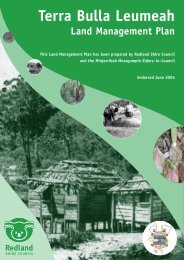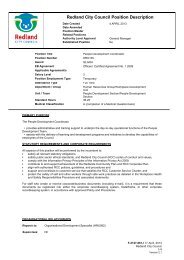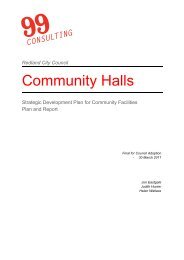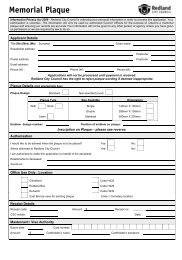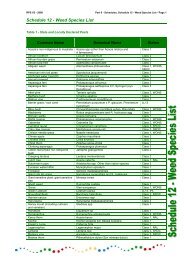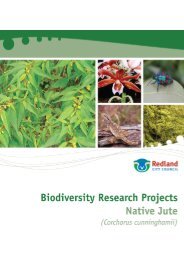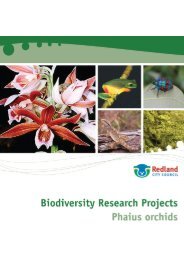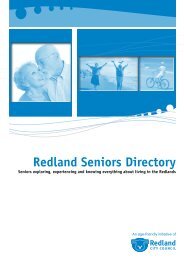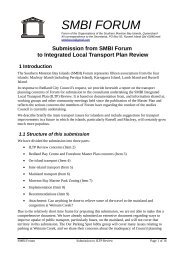Land for Wildlife Newsletter - IndigiScapes
Land for Wildlife Newsletter - IndigiScapes
Land for Wildlife Newsletter - IndigiScapes
Create successful ePaper yourself
Turn your PDF publications into a flip-book with our unique Google optimized e-Paper software.
ook reviews<br />
Field Guide to the Frogs of Queensland<br />
By Eric Vanderduys<br />
It has been quite a few years since a<br />
photographic field guide to Australian<br />
frogs was published making this book<br />
is a welcome new release. Although I<br />
suspect this book will not be as popular<br />
as chocolates under the Christmas tree,<br />
it is a great gift <strong>for</strong> those with an interest<br />
in our summertime noisy amphibious<br />
neighbours.<br />
It is a compact book, full of colour<br />
photographs and is easy to follow with<br />
one species described per page. Each<br />
of the 132 species described has one or<br />
more photographs, a distribution map,<br />
detailed descriptions and a list of similar<br />
species.<br />
Like all good frog field guides, the<br />
five Families of native frogs and one<br />
introduced Family (Bufonidae - Cane<br />
Toads) are introduced separately with<br />
dichotomous keys presented <strong>for</strong> each<br />
Family. To help decipher technical terms<br />
in the keys, excellent anatomical diagrams<br />
are shown in the introduction.<br />
The author clearly has a passion <strong>for</strong><br />
frogs and their conservation over many<br />
decades. The short introduction gives the<br />
reader an insight into some of his travels<br />
and how frogs have evolved to live in<br />
both the dry deserts and wet tropics of<br />
Queensland. Eric’s concerns about the<br />
survival of some of our native frogs and<br />
their habitats is unequivocal; particularly<br />
frogs in highly populated areas such as<br />
SEQ as their habitats are being filled in<br />
and drained <strong>for</strong> humans, as well as frogs<br />
that live on remote cool mountain tops<br />
and will have nowhere to go as global<br />
temperatures rise.<br />
This book is easy to read, enjoyable to<br />
flick through, and will be useful in the<br />
field. A great addition to any wildlife<br />
enthusiast’s library.<br />
Published by CSIRO Publishing, 2012<br />
Paperback, colour photos, 208 pages.<br />
ISBN: 9780643106307<br />
Price: $45<br />
Available from CSIRO Publishing<br />
and all good bookshops.<br />
Australian Lizards: A Natural History<br />
By Steve K Wilson<br />
The author admits up front that he has<br />
been “completely enraptured by the<br />
charm of lizards” since he was a toddler.<br />
This book represents a lifetime of enjoying<br />
lizards and is a remarkable synthesis of such<br />
knowledge. We are very lucky to be able to<br />
access such knowledge and the incredible<br />
photographs throughout this book.<br />
This book showcases lizards based on what<br />
lizards do, such as what they eat, how they<br />
regulate their temperature, how they breed<br />
and how they survive the extremes of<br />
Australia. The photographs are remarkable<br />
showing lizards shedding their skins, eating<br />
spiders, sipping nectar, keeping cool in the<br />
desert, laying eggs, displaying breeding<br />
plumage and camouflaging themselves. The<br />
images alone tell countless stories about<br />
the often secret lives of our lizards.<br />
Lizards are divided into four main groups<br />
- skinks, dragons, monitors and geckos.<br />
Australia has half of the world’s total<br />
number of monitors with 27 species found<br />
in every state except Tasmania. With over<br />
420 species, Australia has the greatest<br />
diversity and abundance of skinks anywhere<br />
on Earth. There are over 70 species of<br />
dragons in Australia and provide fascinating<br />
examples of convergent evolution whereby<br />
unrelated, but incredibly similar looking,<br />
species inhabit similar ecological niches.<br />
Finally, geckos, of which Australia has 30<br />
named species including the introduced<br />
Asian House Gecko, considered the world’s<br />
most invasive lizard.<br />
The Perentie is Australia’s largest lizard<br />
reaching 2 metres in length and is a<br />
member of the Family Varanidae (monitors).<br />
Monitors are comparably quite intelligent<br />
and are known to memorise tracks and<br />
features in a landscape and are able to<br />
recognise individual humans.<br />
Packed full of facts and amazing stories, this<br />
is a book to pick up and enjoy over and over<br />
again. It does not try to be a field guide but<br />
is more of a personal tribute to our amazing<br />
lizards. Thank you Steve <strong>for</strong> writing this.<br />
Published by CSIRO Publishing,<br />
2012<br />
Paperback, 208 pages.<br />
ISBN: 9780643106406<br />
Price: $49.95<br />
Available from CSIRO Publishing<br />
and all good bookshops.<br />
Reviews by Deborah Metters<br />
<strong>Land</strong> <strong>for</strong> <strong>Wildlife</strong> South East Queensland January 2013 13



